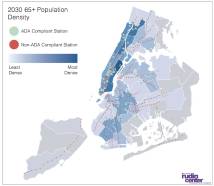Older New Yorkers and Access-A-Ride Forecasts
More than 993,000 people, or 12 percent of the New York City population, are adults over the age of 65. As the “baby boomer” cohort begins to age past 65, adults over the age of 65 are projected to reach 20% of the nation’s population by 2030. New Yorkers over 65 grew by 5.5 percent between 2000 and 2010, presenting a challenge to New York City’s transportation infrastructure. Many older adults are not physically able to use public transportation, often because of a lack of subway station accessibility. Instead, they rely on the Access-A-Ride (AAR) paratransit system, an American with Disabilities Act (ADA) mandated service operated by the Metropolitan Transportation Agency (MTA) and partially subsidized with New York City funds, that provides door-to-door transportation for riders who are unable to use the buses or subways. In 2015, AAR users over the age of 65 accounted for 69 percent of all registrants. AAR operations will cost a projected $505.7 million in 2016 and have experienced annual growth, according to the MTA: in 1994, AAR provided 424,239 trips to 25,446 registrants; in 2015, AAR provided 6,360,165 trips to 144,692 registrants. Demand for AAR is expected to increase as the city’s population of older adults grows; the MTA forecasts that the year 2022 will see 14,322,120 trips for 316,907 users, requiring a scaling up of the already overburdened system. This report attempts to forecast an increase in demand for AAR by location and make recommendations for accessibility reform.
